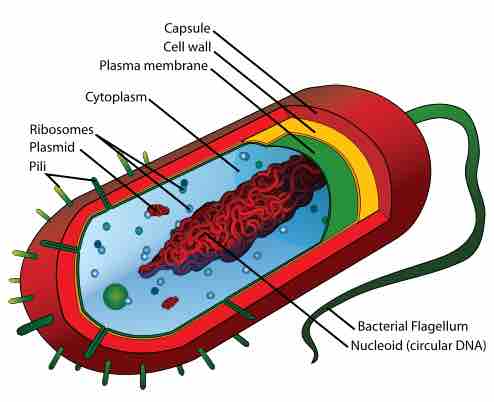Cytoplasmic Membrane
The bacterial cytoplasmic membrane plays a role in permeability and energy conservation in microbial cell structure. The cytoplasmic membranes in bacteria are composed of a phospholipid bilayer; this layer differs from those found in eukaryotes in their lack of sterols. The membranes however, may contain compounds called hopanoids and various fatty acids as well.
The fatty acids present within the cytoplasmic membrane are categorized into classes based on the addition of functional groups; methyl or hydroxyl groups are two examples of such groups. The cytoplasm itself is enclosed within the membrane. In bacteria it lacks the structures seen in eukaryotic cells, including a mitochondria, nucleus, or chloroplasts. The components of the microbial cytoplasm include macromolecules, smaller molecules, various inorganic ions, and cytoplasmic inclusions. The macromolecules included in a bacterial cytoplasm include proteins, DNA, RNA molecules. Smaller molecules include precursors to macromolecules and vitamins. Below is an overview of the components found in microbial cytoplasm based on chemical analysis .

Typical Prokaryotic Cell
Structure of a typical prokaryotic cell. Note the location of the cytoplasm and its components.
Cytosol
The cytosol is a major component of the cytoplasm; it is the liquid portion of the cytoplasm that is not enclosed within a membrane-bound component. The cytosol is typically composed of water, salts, and organic molecules. Elements found within the cytosol include carbon, hydrogen, nitrogen, oxygen, phosphorous, and sulfur. These elements are critical to metabolic processes used by microbes.
Macromolecules
Macromolecules found within bacterial cytoplasm include the nucleoid region, ribosomes, proteins, and enzymes. The nucleoid region is the area within the cell that houses the genetic material. Prokaryotes may sometimes contain an extra chromosomal piece of DNA referred to as the plasmid. The ribosomes, similar to ribosomes in eukaryotes, are responsible for protein synthesis. Unlike eukaryotes, prokaryotes, specifically bacteria, typically contain one cytosol-specific ribosome. Eukaryotes have multiple types of ribosomes, including the mitochondria and cytosol).
Cytoplasmic Inclusions
Another group of substances found within the cytoplasm include small particles referred to as inclusions. These inclusions are characterized by their granular appearance and insolubility. They are suspended in the cytosol.
Inclusions vary, based on cell types. Typically, inclusions function as reserve materials. In prokaryotes, for example, lipid droplets are plentiful in cells which require lipid storage mechanisms. These lipid droplets store molecules such as fatty acids which are present in the cytoplasmic membrane of prokaryotes. E. coli offers another example of bacterial inclusions. These E. coli inclusions are composed of protein aggregates. In addition, inclusions can contain phosphate reserves, sulfur reserves, or photosynthetic pigments.